
Category Archive: Historic Properties
-
Pennsylvania Rail Museum Gets Critical $5M
By Marie Wilson
PITTSBURGH TRIBUNE-REVIEW
Friday, June 4, 2010More than 40 pieces of Pennsylvania’s railroad history are deteriorating from sun, rain, snow and wind as they sit outside the Railroad Museum of Pennsylvania in Lancaster County.
But $5 million from Gov. Ed Rendell’s office will help build an indoor facility to house the artifacts.
“That kind of money will certainly enable it to be upgraded and attract a much larger audience,” said Arthur Ziegler, president of Pittsburgh History & Landmarks Foundation. “That’s good for Pennsylvania particularly — not only because it’s a nostalgic interest in railroads and a historic interest in how they served the country, but railroads are on the way back.”
Design of a roundhouse — an indoor shelter for locomotives — will require about $500,000 of the money released Thursday, said Charles Fox, museum director. The remainder will go toward design and construction of an interpretive exhibit to better explain the commonwealth’s railroad history.
The focus of the exhibit’s redesign is not to acquire artifacts but, instead, to better connect the railroad industry’s past to the present, said Kirk Wilson, spokesman for the Pennsylvania Historical and Museum Commission.
“It is important to the future of the railroad and to be able to tell an aspect of Pennsylvania history,” Wilson said.
The museum hired Gerard Hilferty and Associates, an Ohio-based museum design company, to redesign the internal exhibit, Wilson said. Hiring a design company is the next step in constructing the roundhouse.
“We don’t want it to be all about the machines,” Fox said. “It’s a way to tie it all together into a comprehensive story and to make it about people.”
-
Pa. Historical Panel Raises Concerns About Mellon Arena
Thursday, June 17, 2010By Katie Falloon, Pittsburgh Post-GazetteThe Pennsylvania Historical and Museum Commission has expressed concerns about the speed of the planned demolition of the Mellon Arena, prompting a response today from the Sports & Exhibition Authority.
In the commission’s letter sent Wednesday, director Jean Cutler requested more information.
“We are sympathetic with the need to move quickly, however we also want to ensure that we have received all crucial information in a fashion that allows us to fully understand both the process and the project’s effects on historic resources,” Ms. Cutler said in the letter.
Following today’s SEA board meeting, Executive Director Mary Conturo said members think moving through the process quickly is best, Ms. Conturo said. Mellon Arena will be vacant come August, and the costs of maintaining the building will fall on SEA, she said.
Utilities and insurance for the arena will cost between $78,000 and $100,000 per month, depending on whether the intention is to keep the arena dark or there is an opportunity for reuse, said Christen Cieslak, principal at Chronicle Consulting.
“We think everything done to date is very thorough and very well done,” Ms. Conturo said.
-
Garden Theatre Plans in Works
By Sam Spatter, FOR THE PITTSBURGH TRIBUNE-REVIEW
Thursday, June 17, 2010Five developers — three from out of town — are scheduled to present plans for redevelopment of the Garden Theatre block in the North Side to residents at a community meeting next month.
“This will give the developers an opportunity to explain their plans and for the residents to offer their comments,” said Mark T. Fatia, executive director, Northside Leadership Conference, which received the proposals this week.
The developers are considering a mix of residential and first-floor commercial, Fatla said.
The two local developers are Barron Commercial Real Estate of Pittsburgh and Aaron Stubna of Coraopolis.
The out-of-town developers are Resaca LLC of Bethesda, Md., Wells and Co., Spokane, Wash.; and Zukin Development Corp., of Philadelphia.
Fatla said developer Bill Barron has been active along Butler Street in Lawrenceville, and has started work along Federal Street on the North Side. Stubna is only interested in the Garden Theatre, which he would use for films and art projects.
Resaca, an apartment developer, is interested primarily in the Bradberry Building, a former department store.
Zukin, who recently purchased the drug store at Forbes and Murray in Squirrel Hill, is interested in historic preservation, a similar concept from Wells, which was attracted to Pittsburgh by Mike Edwards, president of the Pittsburgh Downtown Partnership, who formerly served in that capacity in Spokane.
“It will be up to the residents and the conference board to select a developer or developers, since some proposals do not include all of the properties within the block,” Fatla said. That could occur by the end of summer.
The block is bounded by Federal Street on the east, W. North on the south, Reddour Street on the west and Eloise Street, on the north. A previous failed development attempt by Jim Aiello Jr. involved only the Federal Street site, which was 30 percent of the total block project, Fatla said.
-
Sewickley Tour Offers Glimpse at Early 1900s Garden
By Joanne Braun
SEWICKLEY HERALD
Thursday, June 17, 2010When Janice and Ronald West moved into their Sewickley Heights home 15 years ago, remnants of the past scattered the property.
One such remnant is an old cherub statue perched in the middle of The Gardens of Poplar Hill on the Country Club Road property. It will be included in the Sewickley Civic Garden Council’s garden tour Friday.
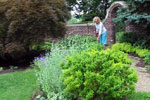
Sewickley Civic Garden Council's garden tour on Friday includes five private gardens within a few blocks of the Edgeworth Club, and a sixth, The Gardens of Poplar Hill in Sewickley Heights, adjacent to Allegheny Country Club. Carolyn Smith, garden tour event coordinator, checks out a few specimens at the Poplar Hill gardens. Joanne Braun | Sewickley Herald
The cherub, which sits in the lower garden, is surrounded by plants, shrubs, brick walls, black iron gates and a roofed summer house, all dating back to the early 1900s. The garden is being cataloged as a historic garden for the Smithsonian Institution in Washington. Village Garden Club’s Garden History and Design committee provided research and documentation — the first time the club, which is a member of the Garden Club of America, has attempted such an undertaking.
Committee members Cathy Snyder, Cordelia Jacobs, Alisa Lenhardt and Lisa Burrows will send their work to the club’s Garden Club of America’s zone coordinator in Philadelphia. Once the research and photos are approved, it will be sent to the Smithsonian for inclusion in the Archives of American Gardens.
Kelly Crawford, museum specialist at the Smithsonian, said the Archives of American Gardens collection captures more than 6,500 American gardens in 80,000 images, historic records, illustrations and plans.
“Some of these records fix a moment in the life of an existing garden, and others describe gardens that are no longer in existence,” she said.
Snyder said Arthur Shurcliff, a member of an architectural firm that became famous for its garden designs, designed the original landscaping at Poplar Hill in 1914.
The property once featured a 35-room carriage house, which later was torn down by a new owner. The property housed numerous families over the years who added structures, sold off some of the land and subdivided it.
In 1948, The Gardens of Poplar Hill were chosen as featured gardens at the Garden Club of America annual meeting. It was part of a tour sponsored by Pittsburgh History and Landmarks Foundation in 1997.
When the Wests moved in, they refurbished much of the deteriorating brickwork, rehung the iron gates, reconstructed and refurbished the limestone windows within the brickwork, and replaced the roof and copper gutters on the summer house.
At that time, most of the flower beds were empty. Poplar trees, for which the property was named, once grew outside the brick walls but were lost to disease in the 1960s.
“There were very little perennials left. We had to start over with the plantings,” Janice West said.
However, large specimen trees, bushes and hedges still flourished throughout the property, and peonies and Japanese iris remained in the lower garden.
As visitors enter the lower garden, they can walk on pathways of blue slate and pea gravel that wind around the inside courtyard. Niches with two Japanese statues, with shallow pools in front of each, face one another across the courtyard.
Also featured are blue spruce and juniper surrounding the side of the house. Dark green boxwood blends with the softer pastel hues of Russian sage and astilbe. Not far away are colored foxgloves and coneflowers mixing with japonica and peonies. Blue geraniums and Japanese grass also make a home in the garden.
“I try to repeat some of the same plants in different spots,” West said.
The couple purchased and placed stone urns to replicate those in photographs from the 1930s atop two brick pillars closer to the house.
Nearby are more large shrubs, which were not there in the original landscape.
“There used to be lillies and flowers along the way. This was just a walkway to the house. I thought about taking the bushes out, but they are so mature,” West said.
As visitors continue to the back of the house, they will get a view of the Allegheny Country Club’s fairways and clubhouse.
That side of the house features an added greenhouse and a large birdbath along with a horseshoe hedge of yews believed to be part of the original landscape. The Wests added more mature yews to the hedges to complete the horseshoe shape, which now surrounds the original English wellhead and two large swamp cypresses. Janice West planted a vegetable garden on the eastern side of the house in the rear, near to where other such gardens originally grew. Plants are held up by trellises of different colors.
In a document prepared for the Smithsonian, committee members wrote, “Without question, Poplar Hill remains a significant treasure in garden design. The fact that it is in the hands of genuine enthusiasts who understand and appreciate the importance of documenting its evolution, preserving its integrity and sharing its beauty with others bodes well for the future.”
If you go
What: Sewickley Civic Garden Council’s garden tour, including five private gardens within a few blocks of the Edgeworth Club. The sixth, The Gardens of Poplar Hill in Sewickley Heights, is adjacent to Allegheny Country Club.
When: 9 a.m. to 4 p.m. Friday. Jan Godshalk, award-winning floral designer, will present a floral arranging demonstration at a luncheon at the Edgeworth Club from noon to 1:30 p.m.
Cost: $20, or $35 for the demonstration. Lunch not included. A combination ticket for the tour and lecture is $50. Tickets are available in Sewickley at Cuttings, Walnut Street; The Gift Corner, Broad Street; and Penguin Book Store, Spoiled Chics and Cheers, Beaver Street.
For more information: Visit www.sewickleygardens.org.
-
Pittsburgh City Council Approves Bill to Inventory War Monuments
Wednesday, June 16, 2010Pittsburgh Post-GazettePittsburgh’s public works, planning and parks and recreation departments must inventory war monuments in the city and develop a 10-year maintenance plan under legislation given final approval Tuesday by Pittsburgh City Council.
Council also passed bills creating a trust fund for war monument maintenance citywide and earmarking $20,000 from Council President Darlene Harris’ discretionary funds to repair a Troy Hill monument run over by a minivan in February.
Mrs. Harris, who sponsored the bills, said she saw a need to improve memorial care because little has been done so far to repair the Troy Hill landmark.
City officials have said the restoration of that monument has been delayed by legal and insurance issues involving the minivan driver. Under Mrs. Harris’ legislation, any money recouped from that case will be used to maintain other memorials on the North Side.
The trust fund will hold money the city budgets or receives to care for war monuments citywide. Under an amendment Mrs. Harris offered at the meeting, the fund also will hold money used to repair monuments to “citizen soldiers,” such as police and other public-safety servants.
-
Historical Societies Foster Pride and Preservation
By Matthew Santoni
PITTSBURGH TRIBUNE-REVIEW
Thursday, June 10, 2010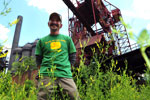
Ronald A. Baraff, director of museums and archives for the Rivers of Steel Heritage Area, which chronicles the history and culture of the industries and mill towns along the rivers, visits the former Carrie Furnace steel mill site in Braddock. Rivers of Steel recently acquired the site from the county to turn into a museum. Sidney Davis | Tribune-Review
The statue of Pittsburgh Pirates legend Honus Wagner might stand outside PNC Park on the North Shore, but fans who desire something more can head six miles down the Parkway West to the Historical Society of Carnegie’s miniature museum to learn about its native son.
In a historic building along West Main Street, a small exhibit on Wagner shares space with yearbooks and photos from area schools, a memorial wall for the town’s military veterans, and a painstakingly crafted scale model of the borough’s buildings along East and West Main Street, all funded without help from the municipality.
“We support ourselves. We figured it was better to be people-funded rather than tax-funded,” said Marcella McGrogan, executive director of the society. “Our town’s streets and parking lots need the help more than we do.”
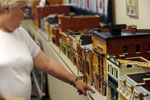
Volunteer Joan Harbin points out a model of the building housing the artifacts and exhibits on display at the Historical Society of Carnegie in the small museum on West Main Street. Keeping up with the maintenance of the building and expansion plans has been a struggle, but officials say local history groups, such as the Carnegie's, help to instill local pride and encourage tourism and redevelopment. James Knox | Tribune-Review
Carnegie is one of many communities in the region with a historical society, which officials say can encourage economic development by drawing tourists, instilling local pride and marketing a community’s historic assets.
“We have a ‘Babushkas and Hardhats’ tour … that looks at the development of the Pittsburgh region, why industry located here, why it isn’t here now and how Pittsburgh has reinvented itself,” said Ron Baraff, director of museums and archives for the Rivers of Steel Heritage Area, which chronicles the history and culture of the industries and mill towns along the rivers.
About 15 acres of the former Carrie Furnace steel mill site in Rankin and Braddock were transferred from the county to Rivers of Steel, and officials hope to turn the former blast furnaces into a museum.
“The idea is to bring people into the region and get them to understand that the past built the present, that that’s the foundation for the future,” he said.
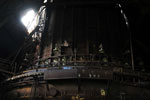
About 15 acres of the former Carrie Furnace steel mill site in Rankin and Braddock were transferred from the county to Rivers of Steel, and officials hope to turn the former blast furnaces into a museum. Sidney L. Davis | Tribune-Review
How and why it helps
The Young Preservationists Society of Pittsburgh released a report last month estimating that preserving and restoring historic properties added at least $475 million to Southwestern Pennsylvania’s economy from 2003 to 2009. Local historical societies can encourage such redevelopment and reinvestment by making people more aware of the history of their communities and homes, said Arthur Ziegler, president of the Pittsburgh History and Landmarks Foundation.
“People tend to believe in the value of that area and are more willing to invest, particularly in historic buildings,” Ziegler said. “It can also develop visitor interest, which can bring income to a town.”
The Sewickley Valley Historical Society is too small to maintain a museum space of its own, but its library allows people to research the history of their families or their homes, said Harton Semple, executive director.
“We’re a small society — only about 400 members — but we have a rich history to draw upon,” Semple said. “We are assailed on all sides by development and general apathy, but we’re beating back that tide.”
The Sewickley Valley society’s “nest egg” was hit hard by the recession, but it has sustained itself with members who made donations above and beyond their yearly membership dues, Semple said. The group published a history of Sewickley last year, and is beginning a push to fund and erect historical markers around the area, he said.
The Historical Society of Mt. Lebanon charges a small fee for its “home history project,” which presents homeowners with a report on the architect who designed their houses, construction plans for them and any other tidbits that members of the historical society can dig up, said Executive Director Margaret Jackson.
Mt. Lebanon’s society is entering its second year of operating a small museum space off Washington Avenue, which hosts rotating exhibits on local subjects such as the nearby Washington School or the Mt. Lebanon Soccer League, Jackson said. More and more residents are donating artifacts and photographs, but that raises the new challenge of how to store and protect them all. Yearly contributions from the municipality’s budget are enough to cover rent on the museum space, she said.
“We’re slowly getting the word out that we’re here, that we’re not just for little old ladies,” Jackson said. “Mt. Lebanon is just celebrating our centennial. … Hopefully, we’ll preserve our community’s past for decades to come.”
The Westmoreland County Historical Society this week moved its library and museum space to a new location on Sand Hill Road, which is more accessible to the many people who use its archives to research their family’s past, said Executive Director Lisa Hays.
“What’s surprising is how far people will travel to study their genealogy. … We had people come from as far away as Australia last week,” Hays said. “Typically, one person will sit and do research while the rest of the family goes out and sees the local sights.”
Hays said local societies help residents understand their communities’ place in the larger events of history, and knowing what roles they played or how they were affected can foster civic pride.
“Everyone thinks nothing ever happened in their backyard, but it did — everything that’s happened on a national level, on a world level, was played out on a local level,” she said. “Once that dawns on people, it creates a real sense of local pride.”
-
Historical Societies Foster Pride and Preservation
By Matthew Santoni
PITTSBURGH TRIBUNE-REVIEW
Thursday, June 10, 2010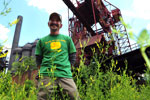
Ronald A. Baraff, director of museums and archives for the Rivers of Steel Heritage Area, which chronicles the history and culture of the industries and mill towns along the rivers, visits the former Carrie Furnace steel mill site in Braddock. Rivers of Steel recently acquired the site from the county to turn into a museum. Sidney Davis | Tribune-Review
The statue of Pittsburgh Pirates legend Honus Wagner might stand outside PNC Park on the North Shore, but fans who desire something more can head six miles down the Parkway West to the Historical Society of Carnegie’s miniature museum to learn about its native son.
In a historic building along West Main Street, a small exhibit on Wagner shares space with yearbooks and photos from area schools, a memorial wall for the town’s military veterans, and a painstakingly crafted scale model of the borough’s buildings along East and West Main Street, all funded without help from the municipality.
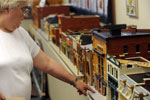
Volunteer Joan Harbin points out a model of the building housing the artifacts and exhibits on display at the Historical Society of Carnegie in the small museum on West Main Street. Keeping up with the maintenance of the building and expansion plans has been a struggle, but officials say local history groups, such as the Carnegie's, help to instill local pride and encourage tourism and redevelopment. James Knox | Tribune-Review
“We support ourselves. We figured it was better to be people-funded rather than tax-funded,” said Marcella McGrogan, executive director of the society. “Our town’s streets and parking lots need the help more than we do.”
Carnegie is one of many communities in the region with a historical society, which officials say can encourage economic development by drawing tourists, instilling local pride and marketing a community’s historic assets.
“We have a ‘Babushkas and Hardhats’ tour … that looks at the development of the Pittsburgh region, why industry located here, why it isn’t here now and how Pittsburgh has reinvented itself,” said Ron Baraff, director of museums and archives for the Rivers of Steel Heritage Area, which chronicles the history and culture of the industries and mill towns along the rivers.
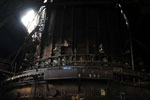
About 15 acres of the former Carrie Furnace steel mill site in Rankin and Braddock were transferred from the county to Rivers of Steel, and officials hope to turn the former blast furnaces into a museum. Sidney L. Davis | Tribune-Review
About 15 acres of the former Carrie Furnace steel mill site in Rankin and Braddock were transferred from the county to Rivers of Steel, and officials hope to turn the former blast furnaces into a museum.
“The idea is to bring people into the region and get them to understand that the past built the present, that that’s the foundation for the future,” he said.
How and why it helps
The Young Preservationists Society of Pittsburgh released a report last month estimating that preserving and restoring historic properties added at least $475 million to Southwestern Pennsylvania’s economy from 2003 to 2009. Local historical societies can encourage such redevelopment and reinvestment by making people more aware of the history of their communities and homes, said Arthur Ziegler, president of the Pittsburgh History and Landmarks Foundation.
“People tend to believe in the value of that area and are more willing to invest, particularly in historic buildings,” Ziegler said. “It can also develop visitor interest, which can bring income to a town.”
The Sewickley Valley Historical Society is too small to maintain a museum space of its own, but its library allows people to research the history of their families or their homes, said Harton Semple, executive director.
“We’re a small society — only about 400 members — but we have a rich history to draw upon,” Semple said. “We are assailed on all sides by development and general apathy, but we’re beating back that tide.”
The Sewickley Valley society’s “nest egg” was hit hard by the recession, but it has sustained itself with members who made donations above and beyond their yearly membership dues, Semple said. The group published a history of Sewickley last year, and is beginning a push to fund and erect historical markers around the area, he said.
The Historical Society of Mt. Lebanon charges a small fee for its “home history project,” which presents homeowners with a report on the architect who designed their houses, construction plans for them and any other tidbits that members of the historical society can dig up, said Executive Director Margaret Jackson.
Mt. Lebanon’s society is entering its second year of operating a small museum space off Washington Avenue, which hosts rotating exhibits on local subjects such as the nearby Washington School or the Mt. Lebanon Soccer League, Jackson said. More and more residents are donating artifacts and photographs, but that raises the new challenge of how to store and protect them all. Yearly contributions from the municipality’s budget are enough to cover rent on the museum space, she said.
“We’re slowly getting the word out that we’re here, that we’re not just for little old ladies,” Jackson said. “Mt. Lebanon is just celebrating our centennial. … Hopefully, we’ll preserve our community’s past for decades to come.”
The Westmoreland County Historical Society this week moved its library and museum space to a new location on Sand Hill Road, which is more accessible to the many people who use its archives to research their family’s past, said Executive Director Lisa Hays.
“What’s surprising is how far people will travel to study their genealogy. … We had people come from as far away as Australia last week,” Hays said. “Typically, one person will sit and do research while the rest of the family goes out and sees the local sights.”
Hays said local societies help residents understand their communities’ place in the larger events of history, and knowing what roles they played or how they were affected can foster civic pride.
“Everyone thinks nothing ever happened in their backyard, but it did — everything that’s happened on a national level, on a world level, was played out on a local level,” she said. “Once that dawns on people, it creates a real sense of local pride.”
-
HRC Gives Conditional Nod to Apartments in Old Uptown School
Thursday, June 03, 2010By Diana Nelson Jones, Pittsburgh Post-GazetteThe Historic Review Commission Wednesday conditionally approved the plans of an investment group to renovate the former Fifth Avenue High School, Uptown, into 65 rental lofts.
Casey Steiner and Jonathan Hill, on behalf of the new owner, an investment partnership called LMS 5th LP, said they propose to restore the exterior to national historic standards and build a new parking lot of two levels, the higher about 3.5 feet above sidewalk level on the Fifth Avenue side to be accessible to the handicapped.
Provided financing “falls into place,” Mr. Steiner said, work on the 5th Avenue School Lofts could be under way by fall. “We’re pretty confident.”
The market, he said, is graduate students, empty nesters, people who work Downtown, in Oakland, at Mercy Hospital and Duquesne University.
The commission’s conditions are that the development partners provide more detail of the composition of concrete facing on the parking deck, screening of the deck and railings.
The investors provided historic planner Katherine Molnar proof of approval from the U.S. Department of the Interior, which is charged with upholding historic standards. The former school is a nationally designated historic structure, and the investment will receive federal historic tax credits.
Mr. Steiner, president of Impakt Development, said the partnership paid $640,000 last year for the building from Excel Kitchens, which operated out of a small part of the school, which was built in 1894, closed in 1976 and was otherwise empty that long.
In other matters, the commission approved Eat’n Park Hospitality Group’s plan to build a restaurant in Schenley Plaza, nearest where Forbes Avenue and Pennant Place meet.
The building will have two living walls, a green roof on which herbs and vegetables will be grown for the restaurant and a rain barrel will collect water. It will be one-story, built of limestone, red cedar, a metal canopy, glass and stacked stone. Facing the park, it will have a “transitional patio” — covered but without walls, said Mark Broadhurst of the Eat’n Park Hospitality Group. It has not been named but will not be called Eat’n Park, he said.
The project is being financed by the hospitality group, said Mr. Broadhurst. The group will lease from the Pittsburgh Parks Conservancy.
